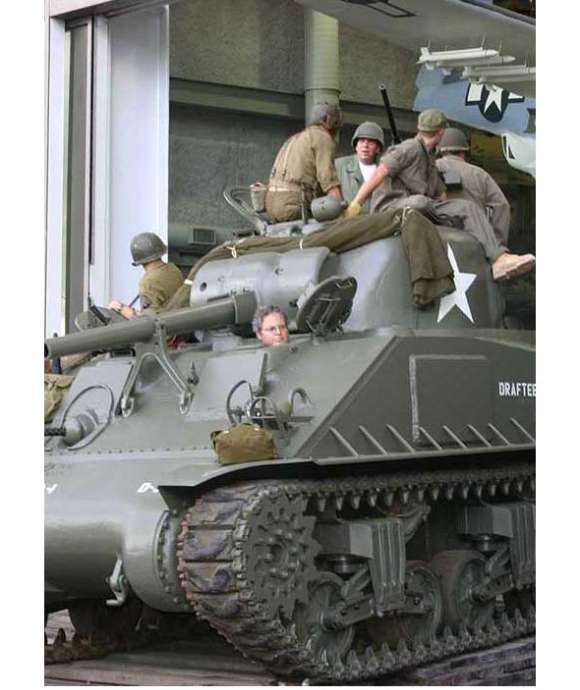Top Image: 1941 Ford GP on the Assembly Line. Courtesy of The National WWII Museum.
When restoring large artifacts, like vehicles, the final finish, normally paint, will be one of the most noticed elements of the restoration. Guests looking at a jeep in an exhibit pavilion will rarely see the electrical wiring harness, which is still of course an important part of a restoration. They will see what the final finish looks like. Considerable thought should be put into the appearance, particularly how that appearance relates to the context of the exhibit.
It is very rare to find a large artifact with intact original paint. Preservation of original paint can be difficult and can dictate how an artifact can be exhibited. In the majority of cases vehicles have been painted many times and the current state of the finish dictates stripping off all the old paint and starting fresh. For military vehicles, having a detailed history of the vehicle’s use is as rare as an original finish. Therefore the restorer can paint the vehicle to suit their needs. When considering how to finish your vehicle, you should focus on the particular time frame from the item’s history that you wish to represent. This will help when deciding on exactly what details to include.
The Museum collection contains eight jeeps, including a GP, GPA, GPW, and MB. Each of these jeeps is painted and presented to represent the wide variety of units, theaters, and uses to which the jeeps were put. As a way to illustrate this, let’s look at just three of the jeeps in the Museum’s collection. In the Arsenal of Democracy exhibit, the Museum has a 1941 Ford GP. This jeep is exhibited in factory new condition. It is, after all, placed in an exhibit depicting a factory assembly line. The paint is fresh with no wear and no unit markings since it hasn’t been assigned to a unit. The W number is painted in blue drab. That was factory standard but seldom repeated when reapplied by end users. The jeep is displayed with the body and chassis separated, as portrayed in a photo from the factory. This presentation allows the visitor to see many details normally hidden by the body. Of course this presentation is only suitable for a static exhibit.
In the Campaigns of Courage Pavilion, Road to Berlin Gallery, a 1942 Ford GPW is displayed in an immersive North Africa exhibit. This jeep is exhibited as it would have appeared in the field and includes accessories such as a radio, headlight covers, windshield cover, and field gear from the crew. The jeep has also been splattered with mud and approximates a photo of a jeep after the Battle of Kasserine Pass. The jeep represents one used by a forward observer of the 26th Field Artillery Battalion, 9th Infantry Division, and is marked accordingly. The W number is applied in blue drab paint. As presented, the vehicle would be less than a year old and may not have been repainted at the unit level. This is an excellent example of jeep presented as it appeared in the field. Again, this is suitable for a static exhibit, as it would be difficult to use a vehicle and keep it splattered with mud.
Finally, a 1943 Willys MB is on exhibit in The United States Freedom Pavilion, The Boeing Center. This jeep, like other vehicles in the pavilion, runs; and it is moved on a regular basis to accommodate Museum events. This jeep is marked to represent the 155th Airborne Anti-Aircraft Artillery Battalion with the 17th Airborne Division during Operation Varsity. This unit received two 75mm recoilless rifles for use in that operation. This type of weapon was just being deployed at the end of the war and proved very useful in anti-tank operations. In addition to the recoilless rifle, the jeep features a wire cutter commonly found in the European theater and a limited collection of other accessories. The jeep has appropriate unit markings. The W number is painted in white, as is typically observed after a vehicle has spent time with a unit.
Each of these jeeps represent different time periods and different appearances. When deciding on the appearance of each of these vehicles, extensive reference was made to historic photographs. Period manuals and regulations were also consulted. Together these helped to establish a documented appearance at a particular time with appropriate markings and accessories for each jeep.

SHOP TALK: Sherman Tank Back into the Louisiana Memorial Pavilion
Read the story of restoring the Museum’s Sherman tank to operating condition.
Tom Czekanski
Cite this article:
MLA Citation:
APA Citation:
Chicago Style Citation:


![Max Fuchs, New York City cantor, sings as Rabbi Sydney [sic] Lefkowitz, Richmond, VA, conducts the first Jewish services from Germany.](/sites/default/files/styles/max_650x650/public/2025-10/image1.jpg)






